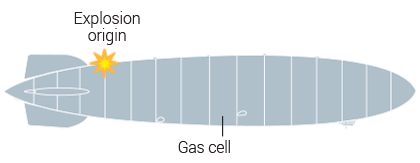Zeppelin LZ129
Flight paths in 1936-37
Route to disaster
Inside the airship
The mooring process
Ground crew used ropes to manoeuvre the ship into position
The explosion occurred in the stern of the airship as it was being moored
Most probable cause
The fire that caused the Hindenburg disaster was most probably ignited by a spark between the ship’s outer cover and its framework
1 The ship passed through rain before arriving at Lakehurst Naval Air Station – perfect conditions to create electrical charges
2 Different electrical charges between the airship and the ground caused a spark that ignited a gas leak
3 The fire spread through gas cells until it destroyed the ship

Victims
Airship accidents
Dozens of hydrogen airships had previously exploded or caught fire. The Hindenburg disaster finally convinced the world that hydrogen was not a safe gas for airships carrying passengers
